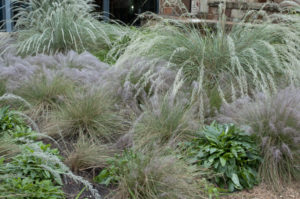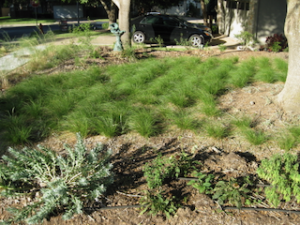The Many Virtues of Ornamental Grasses

Ornamental grasses work well as mass plantings
A good landscape is not just about where you put trees and walkways, it also provides beauty and attracts nature into your yard. As the seasons change so does the color and shape of your garden. Spring brings a burst of new growth. Hopefully in summer there is a variety of flowers and grasses blooming. By fall, late blooms and seeds appear and last through most of the winter. Plants that can do all of this are ornamental grasses.
Additionally, as our Austin weather becomes hotter and drier, drought tolerant plants will be a necessary component of our gardens. Here again, the grasses come to the rescue. Ornamental grasses can handle drought, are low maintenance, attract birds and butterflies, are deer and pest resistant, provide both visual and auditory interest, and remain beautiful for many years.
Growing Conditions for Ornamental Grasses
Depending on your nature, you can either coddle your plants or select plants that can stand on their own in our climate. By starting with native, more adaptable grass, the constant care is not necessary. You can use ornamental grasses to help reduce or eliminate the labor and water intensive lawn without giving up a lush green space.
Most ornamental grasses prefer a sunny, well-drained soil, and are somewhat drought tolerant. Fall and spring are the best times to plant them. Control weeds to give the grass a chance to established itself. Provide light irrigation and mulch the first summer. Subsequent years will be more drought and weed tolerant.
Few grasses prefer shade, one good exception is the shade loving native Inland Sea Oats, (Chasmanthium latifolium). These grasses show long, graceful, arching seed heads which self-seed easily and are sought after by mammals and birds.
Purpose

Texas Sedge, (Carex texensis), is a small clump-forming grass.
Do not mow or walk on your ornamental grasses – even if you are using them as a lawn substitute. Their purpose is to be beautiful, encourage wildlife, and add interest to the landscape. The varieties, shapes, color, and height make finding just the right grass for your purpose a fun study to undertake. Some grasses make beautiful container plants when considering the filler, spiller and thriller idea of container gardening.
Types of Ornamental Grasses to Use
Most references describe ornamental grasses by their root system: clump-forming or running. Nearly all have an upright form, no matter how their roots grow.
Choosing clump-forming grasses and their controlled and tidy growth habit provide contrast and additional interest in the landscape. Both tightly mounded or loose and open varieties are available. Clumps can be small or large depending on the mature height and width of the plant.
Running root systems often characterize grasses native to meadows or prairies. These ornamental grasses form rhizomes or stolons that can extend laterally 12 or more inches.
Design Uses for Ornamental Grasses
With so many grasses that grow well in our more arid climate, you can find varieties to use as ground cover, specimen plants, or combined with other native and nonnative varieties. Grasses make good background plants in a bed or as a filler in large landscape areas. They retain soil to prevent erosion. Most types of grasses are perennials which show subtle color, textures and bring movement. Consider dwarf varieties if you have space limitations.
Ornamental grasses provide contrast to perennials and annuals. Used in borders or beds, they provide movement when the wind blows. Use low grasses in the front of beds or edging along a path. Use towering tall grasses as a focal point or in the background for additional interest and layering. Texture, especially in a delicate grass, can create a calm, restful sensation.
Wildlife Uses
In the fall, the ornamental grasses start to shine providing another dimension to the landscape. Grasses show their graceful arching leaves in autumn when seeds emerge providing beauty all through the winter. This is also a time when birds show most interest in seeds. Grass planted in groups of two or three will allow a bird to hide if necessary. Place a birdbath near the native grass with seed heads as birds prefer the native grass and will be enticed to explore. The grass not only provides food but also a safe resting place and nesting. Birds are most vulnerable to marauders when feeding.
Maintenance
Cut back ornamental grasses after the first freeze or before they show new growth in the spring. Trimming is not necessary, but the plant will look better without all the dead leaves.
Grasses once established need little care but do not neglect them at least the first year as they will need supplemental water the first summer.
Other maintenance includes repotting or dividing the plant every three to four years to help it stay vigorous and healthy. Dividing also provides more plants for your garden or to share with friends. To divide a large grass cut down through middle with a spade into the shoots and roots. Dividing requires some strength so sometimes help is needed to cut through the roots. Once the extra plant is removed fill in the hole with soil and compost.
Additional Resources
Best Ornamental Grasses for Birds
Earth-Kind Landscaping Grass Selection for Region F

Linda Drga is a Lifetime Member of the Travis County Master Gardeners Association. She grew up on a Pennsylvania truck farm and spent her youth working with vegetables. She has a degree in nursing and a MPH (Masters in Public Health) from Tulane. She spent 20+ years living and gardening in South American, the Caribbean, and Africa. She says gardening is her escape and how she keeps her mind at ease. She loves to get dirty in her garden but still dedicates time every day to study and learn something new.
